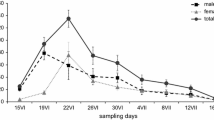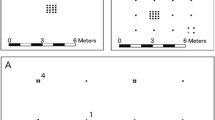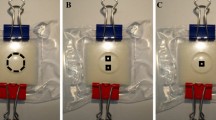Summary
To investigate the relation between the distribution pattern of eggs and the parental density in the common cabbage butterfly,Pieris rapae crucivora, the countings of egg number per plant were made on both cabbage plants cultivated in the farm and planted in the net house in which the female butterflies were released at various densities.
The frequency distribution of eggs fits well to the negative binomial excepting the cases where they agree withPoisson series, and the degree of aggregation expressed as the reciprocal of the parameter, 1/k, tends to decrease as the egg or parental density increases. At the same parental density, however, the distribution of eggs can be described by the negative binomial with a common parameter,k c, regardless of the difference in the density of laid eggs.
In the case where a single female butterfly lays eggs, the spatial pattern of egg distribution is always lean, while its frequencies conform toPoisson or the negative binomial series. This lean changes toward patchy with increasing the parental density.
From these results, it is concluded that the degree of aggregation in the distribution of eggs decreases with the increase of the parental density.
Similar content being viewed by others
References
Anscombe, F. J. (1949) The statistical analysis of insect counts based on the negative binomial distribution.Biometrics,5: 165–173.
Anscombe, F. J. (1950) Sampling theory of the negative binomial and logarithmic series distributions.Biometrika,37: 358–382.
Bliss, C. I. (1958) The analysis of insect counts as negative binomial distributions.Proc. 10th Internat. Cong. Ent. (Montreal),2: 1015–1032.
Bliss, C. I. andR. A. Fisher (1953) Fitting the negative binomial distribution to biological data.Biometrics,9: 176–200.
Bliss, C. I. andA. R. G. Owen (1958) Negative binomial distributions with a commonk.Biometrika,45: 37–58.
Evans, D. A. (1953) Experimental evidence concerning contagious distributions in ecology.Biometrika,40: 186–211.
Haroourt, D. G. (1960) Distribution of the immature stages of the diamondback moth,Plutella maculipennis (Court.), on cabbage.Can. Ent.,92: 517–521.
Harcourt, D. G. (1961) Spatial pattern of the imported cabbageworm,Pieris rapae (L.), on cultivatedCruciferae.Can. Ent.,93: 945–952.
Harcourt, D. G. (1963) Population dynamics ofLeptinotarsa decemlineata (Say) in Eastern Ontario. I. Spatial pattern and transformation of field counts.Can. Ent.,95: 813–820.
Itô, Y. (1962) Distribution of the overwintering arrow-head scale,Prontaspis yanonensisKuwana, on the satsuma orange leaves.Japanese J. Appl. Ent. Zool.,6: 183–189 (in Japanese with English summary).
Iwao, S. (1956) The relation between the distribution pattern and the population density of the large 28-spotted lady beetle,Epilachna 28-maculataMotschulsky, in egg-plant field.Jap. J. Ecol.,5: 130–135 (in Japanese with English summary).
Kobayashi, S. (1960) Studies on the distribution pattern of the eggs of the common cabbage butterfly,Pieris rapae crucivora in a cabbage farm and the factors affecting its concentrating trend.Jap. J. Ecol.,10: 154–160 (in Japanese with English summary).
Kobayashi, S. (1965) Influence of adult density upon the oviposition site in the cabbage butterfly,Pieris rapae crucivora.Jap. J. Ecol.,15: 35–38 (in Japanese with English summary).
Kuno, E. (1963) A comparative analysis on the distribution of nymphal populations of some leaf-and planthoppers on rice plant.Res. Popul. Ecol.,5: 31–43.
Morisita, M. (1959) Measuring of the dispersion of individuals and analysis of the distributional patterns.Mem. Fac. Sci. Kyushu Univ., Ser. E. (Biol.),2: 215–235.
Morris, R. F. (1955) The development of sampling techniques for forest insect defoliators, with particular reference to the spruce budworm.Can. J. Zool.,33: 225–294.
Utida, S., T. Kono, S. Watanabe, andT. Yosida (1952) Pattern of spatial distribution of the common cabbage butterfly,Pieris rapae in a cabbage farm.Res. Popul. Ecol.,1: 49–64 (in Japanese with English summary).
Waters, W. E. (1955) Sequential sampling in forest insect surveys.Forest Science,1: 68–79.
Waters, W. E. (1959) A quantitative measure of aggregation in insects.J. Econ. Ent.,52: 1180–1184.
Yosida, T. (1954) The relation between the population density and the pattern of distribution of the rice-plant skipper,Parnara guttataBremer etGrey.Ôyo-Kontyu,9: 129–134 (in Japanese with English summary).
Author information
Authors and Affiliations
Rights and permissions
About this article
Cite this article
Kobayashi, S. Influence of parental density on the distribution pattern of eggs in the common cabbage butterfly,Pieris rapae crucivora . Res Popul Ecol 7, 109–117 (1965). https://doi.org/10.1007/BF02518794
Issue Date:
DOI: https://doi.org/10.1007/BF02518794




